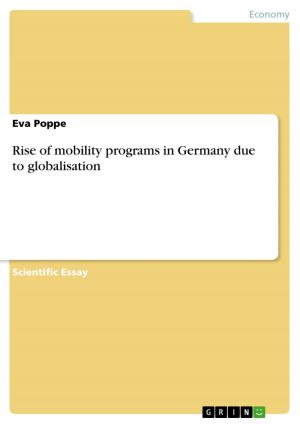VW Phaeton - Did Zeus' anger hit sales of Volkswagen's luxury car
Did Zeus' anger hit sales of Volkswagen's luxury car
Business & Finance, Marketing & Sales| Author: | Sven Röhm | ISBN: | 9783638273442 |
| Publisher: | GRIN Publishing | Publication: | May 3, 2004 |
| Imprint: | GRIN Publishing | Language: | English |
| Author: | Sven Röhm |
| ISBN: | 9783638273442 |
| Publisher: | GRIN Publishing |
| Publication: | May 3, 2004 |
| Imprint: | GRIN Publishing |
| Language: | English |
Essay from the year 2003 in the subject Business economics - Marketing, Corporate Communication, CRM, Market Research, Social Media, grade: 74% (A) entspricht 1,0, University of Teesside (Tesside Business School), course: Managing Markets, language: English, abstract: After the introduction of the first Volkswagen luxury car in May 2002, sales are still far behind the Volkswagen's expectation (Handelsblatt, 2003). It seems that the VW Phaeton faces the same destiny as its antique namesake Phaeton. In the Greek mythology, Phaeton was the son of Helios, the sun god. Helios has driven the family chariot across the sky, wearing the rays of the sun as a crown, lighting the day. One day Phaeton convinced his father to lend him the beautiful chariot. But Phaeton, in contrast to his father, was not able to drive the chariot appropriately, and drove the chariot so close to the earth that he boiled the oceans and scorched the land. So Zeus had to stop him by killing him with a lightning bolt (Vaughn, 2003). Volkswagen certainly had not considered this explanation when naming the Phaeton, but referred more likely to the second meaning of Phaeton; an elegant carriage of the 17th century which the owners drove on their own. Nevertheless, there are signs that the Volkswagen engagement in the high-class (luxury) car market is tougher than expected. It seems people are less persuadable to buy a high-quality car of the experienced and renowned German car manufacturer. This shows the divergence of the formerly targeted 12.000 to 15.000 units (Weernink, 2001) annually in global sales 2003 which is opposed by the actual numbers of only 2.600 units in Germany - the main market of the Phaeton - from January to October (Kraftfahrtbundesamt KBA) and estimated sales of 3500 units worldwide (Handelsblatt, 2003). The targeted sales of 20.000 units in 2004 (Weernink, 2003) seem to be completely unrealistic. But the Volkswagen top-management remained silent. Although Volkswagen always claims that the Phaeton's technology, specifications and passenger protection is absolutely comparable with the competing Mercedes S-Class, BMW 7 and Audi A8, customers seem to spot a big disadvantage of the VW Phaeton - the lack of perception and the missing customer benefit of expressing the driver's status.
Essay from the year 2003 in the subject Business economics - Marketing, Corporate Communication, CRM, Market Research, Social Media, grade: 74% (A) entspricht 1,0, University of Teesside (Tesside Business School), course: Managing Markets, language: English, abstract: After the introduction of the first Volkswagen luxury car in May 2002, sales are still far behind the Volkswagen's expectation (Handelsblatt, 2003). It seems that the VW Phaeton faces the same destiny as its antique namesake Phaeton. In the Greek mythology, Phaeton was the son of Helios, the sun god. Helios has driven the family chariot across the sky, wearing the rays of the sun as a crown, lighting the day. One day Phaeton convinced his father to lend him the beautiful chariot. But Phaeton, in contrast to his father, was not able to drive the chariot appropriately, and drove the chariot so close to the earth that he boiled the oceans and scorched the land. So Zeus had to stop him by killing him with a lightning bolt (Vaughn, 2003). Volkswagen certainly had not considered this explanation when naming the Phaeton, but referred more likely to the second meaning of Phaeton; an elegant carriage of the 17th century which the owners drove on their own. Nevertheless, there are signs that the Volkswagen engagement in the high-class (luxury) car market is tougher than expected. It seems people are less persuadable to buy a high-quality car of the experienced and renowned German car manufacturer. This shows the divergence of the formerly targeted 12.000 to 15.000 units (Weernink, 2001) annually in global sales 2003 which is opposed by the actual numbers of only 2.600 units in Germany - the main market of the Phaeton - from January to October (Kraftfahrtbundesamt KBA) and estimated sales of 3500 units worldwide (Handelsblatt, 2003). The targeted sales of 20.000 units in 2004 (Weernink, 2003) seem to be completely unrealistic. But the Volkswagen top-management remained silent. Although Volkswagen always claims that the Phaeton's technology, specifications and passenger protection is absolutely comparable with the competing Mercedes S-Class, BMW 7 and Audi A8, customers seem to spot a big disadvantage of the VW Phaeton - the lack of perception and the missing customer benefit of expressing the driver's status.















